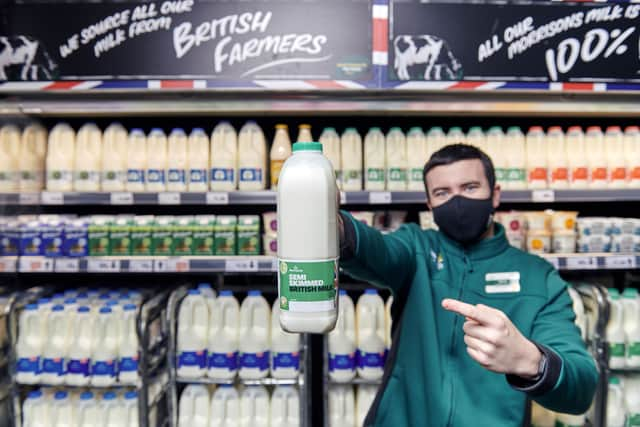Morrisons milk ‘sniff test’: what is it, when will it start and decision to scrap milk use by date explained


Every year, UK farmers produce more than six billion litres of milk for our fridges.
But, according to recycling and food waste prevention charity Wrap, around 278 million litres (490 million pints) of this milk is wasted every year.
Advertisement
Hide AdAdvertisement
Hide AdIn fact, milk is the third most wasted food and drink product in the UK behind only potatoes and bread.
In a bid to stop at least some of this wastage, major supermarket Morrisons has announced plans to scrap use by dates on 90% of its own-brand milk.
The retailer will instead introduce ‘best before’ dates and will encourage consumers to use the sniff test.


But how does a ‘best before’ date differ from a ‘use by’ one, what is the sniff test - and how exactly will these two measures help reduce milk waste?
Here’s everything you need to know.
Best before dates explained
Advertisement
Hide AdAdvertisement
Hide AdIf you look at almost any food or drink item, regardless of whether it’s refrigerated or in a tin, you will either see a ‘use by’ or ‘best before’ date on the packaging.
While the terms might appear to be interchangeable, they actually mean very different things.
‘Use by’ dates relate to food safety and appear on products with a short shelf life, e.g. milk, while ‘best before’ dates are to do with food quality and usually appear on longer-life products.
The Food Standards Agency (FSA), which regulates the safety of all food and drink in the UK, says you can consume products with a ‘use by’ date up to and including the day on which it runs out.
Advertisement
Hide AdAdvertisement
Hide AdBut it states the product should not be eaten, cooked or frozen after this date as it could be unsafe, for example bacteria may have developed which could cause food poisoning.


Items with a ‘best before’ date can be safe to eat once this date has been passed, but may not carry the same flavour or texture.
Under its proposals, Morrisons will move all of its milk products manufactured by dairy supplier Arla from a ‘use by’ date to a ‘best before’ date system.
No date has been set for the move, but it will affect 90% of its own-brand milk products.
Advertisement
Hide AdAdvertisement
Hide AdIt will also encourage consumers to give milk a ‘sniff test’ before consuming it after its ‘best before’ date.
The supermarket has already scrapped ‘use by’ dates on other perishable own-brand dairy products, such as yoghurt and hard cheese.
What is the sniff test?
The sniff test is a method of preventing milk from being wasted by getting consumers to smell it before use.
Morrisons says there are two steps consumers should take to conduct a proper sniff test:
- Hold the milk bottle to your nose - if it smells sour then it may have spoiled
- Look at the milk - if you can see that it has curdled (i.e. it has separated and is lumpy), then it’s not right
Advertisement
Hide AdAdvertisement
Hide AdThe FSA said the sniff test cannot be trusted because, while foods may look or smell fine after their use by date, they could still be contaminated.


However, because all milk in supermarkets has to, by law, be pasteurised - i.e. have 99.9% of the bacteria removed - milk that’s gone off does not pose a risk to health.
How will these measures help reduce milk waste?
Morrisons said its move would prolong the life of milk, as it believes consumers will be less inclined to pour it down the sink once it hits the date on the packaging.
The retailer pointed to research by the US Government and Cornell University, which found unopened milk that has been stored properly in a fridge can last for five to seven days after its ‘use by’ date.
Advertisement
Hide AdAdvertisement
Hide AdMilk that has been opened could last for another two to three days after this deadline.
Meanwhile, Wrap estimated that 85 million pints were wasted as a result of customers sticking to ’use by’ labels or ‘once opened use within’ guidance - when the products may still be good to consume.
Senior milk buyer at Morrisons, Ian Goode, said: “Good quality well-kept milk has a good few days [of] life after normal ‘use by’ dates - and we think it should be consumed, not tipped down the sink.
“So we’re taking a bold step and asking customers to decide whether their milk is still good to drink. Generations before us have always used the sniff test - and I believe we can too.”
Advertisement
Hide AdAdvertisement
Hide AdWrap said the supermarket’s announcement would “give people the confidence to use their judgment and consume more of the milk they buy.”
It added that it hopes other retailers follow Morrisons’ lead.
The charity also said reducing milk waste could help to reduce greenhouse gas emissions.
Wrap said the production of one-litre of milk can account for up to 4.5kg of CO2.
A message from the editor:
Advertisement
Hide AdAdvertisement
Hide AdThank you for reading. NationalWorld is a new national news brand, produced by a team of journalists, editors, video producers and designers who live and work across the UK. Find out more about who’s who in the team, and our editorial values. We want to start a community among our readers, so please follow us on Facebook, Twitter and Instagram, and keep the conversation going. You can also sign up to our email newsletters and get a curated selection of our best reads to your inbox every day.
Comment Guidelines
National World encourages reader discussion on our stories. User feedback, insights and back-and-forth exchanges add a rich layer of context to reporting. Please review our Community Guidelines before commenting.
